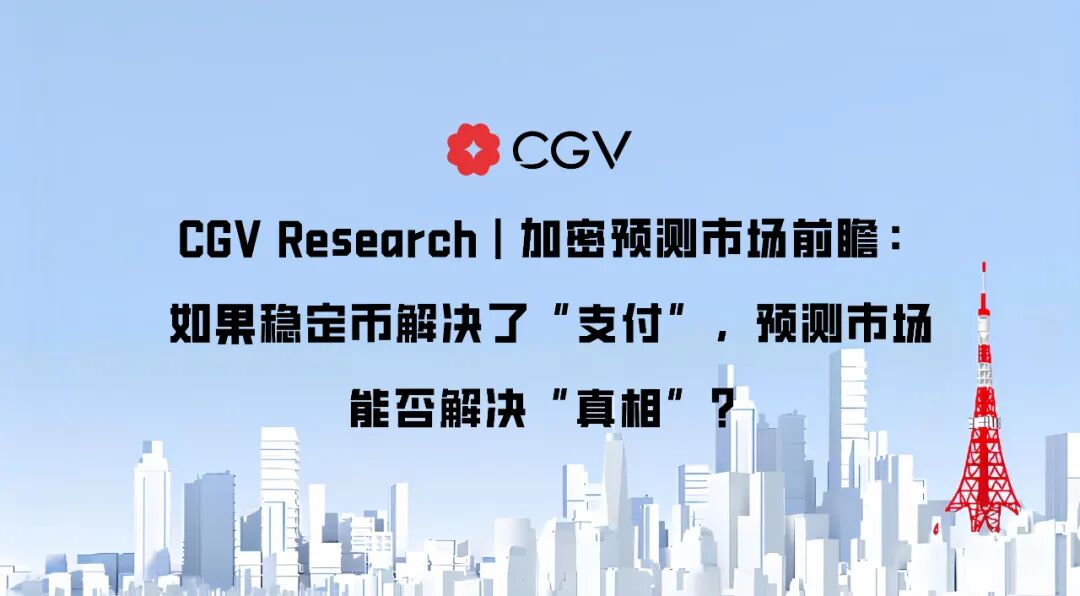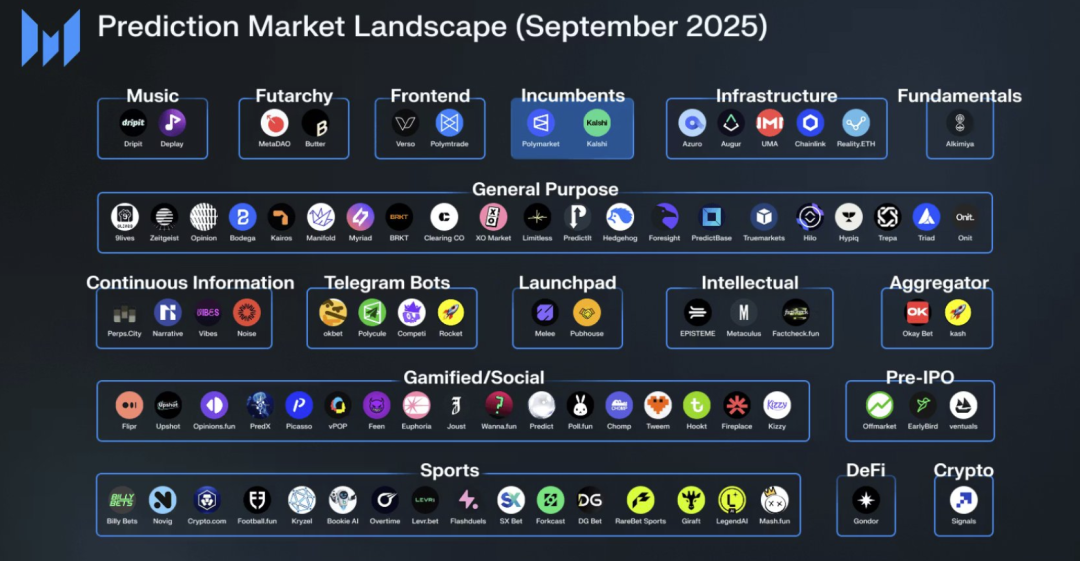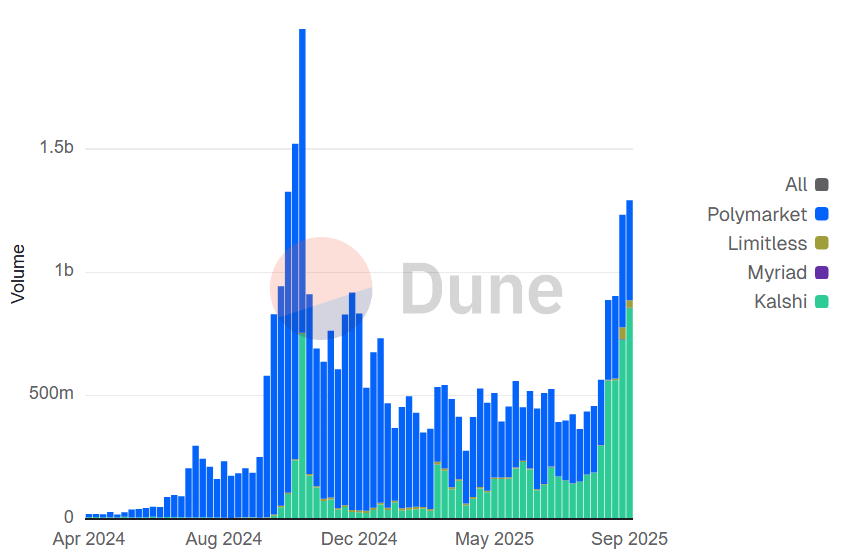Introduction: Stablecoins have proven the "payment value" of crypto, while prediction markets are trying to demonstrate "information value." Within the crypto community, platforms like Polymarket and Kalshi have seen a surge in trading volume, becoming one of the closest tracks to real-world applications; however, outside the community, they are still viewed as gambling, making it difficult to gain mainstream recognition. This article will analyze the current state of prediction markets, their path to breaking out of their niche, and future trends, exploring whether they can become the next cornerstone connecting crypto and reality after stablecoins.
Author: Shigeru
CGV Research

In the past two years, prediction markets have become one of the most controversial yet promising "real-world applications" in the crypto industry: within the community, platforms like Polymarket, Kalshi, and others have established relatively stable traffic and narratives, with trading volumes rapidly climbing; outside the community, however, they are still regarded as gambling, making it hard to enter the asset allocation vision of mainstream investors.
However, questions arise—can prediction markets, like stablecoins, truly break through the barriers and become the next cornerstone connecting the crypto industry with the real world? Can they become the next internet-level fintech product?

Crypto Prediction Market Ecosystem (Messari)
Current Landscape Analysis: Prosperity Within the Community and Cognitive Gap Outside
Why can the same market be hotly debated within the crypto community while receiving little attention outside? Prediction markets are a typical case of "hot inside, cold outside."
On one hand, the heat within the community continues to rise.
Platforms represented by Polymarket, Kalshi, and Manifold have established a relatively stable flow and narrative within the crypto community.

Statistics on the share of crypto prediction markets (Dune, 20251006)
Polymarket, with its simple interface and settlement in US dollar stablecoins, has become an important venue for discussing events such as the U.S. elections, macroeconomic data, and crypto industry airdrops. By 2025, Polymarket's cumulative trading volume had surpassed $7.5 billion, with August trading volume exceeding $618 million, primarily driven by political events and macro predictions. During the 2024 U.S. election, Polymarket set Trump's winning probability at 99% at 1:30 AM ET, while Fox News announced the result only at 1:47 AM, with other media outlets delaying even longer. Continuous arbitrage activities and rising marginal costs that deviate prices from fair value make prediction market errors brief and easily correctable.
Manifold, on the other hand, has attracted over 200,000 users with its "social + prediction" light entertainment model, becoming a "new voting pool" for community users to acquire information and express opinions. However, in 2025, Manifold's daily active users dropped to a historical low of 886, reflecting challenges in user retention.
Additionally, Kalshi has emerged as a compliant platform, with trading volume reaching $1.3 billion in September 2025, capturing 62.2% of global prediction market activity and dominating the market for sports event predictions.
On the other hand, recognition outside the community remains insufficient.
The general public often equates prediction markets with "gambling," lacking an understanding of their value in "information aggregation" and "probability pricing." Even when mainstream U.S. media occasionally reference Polymarket data, the social recognition of prediction markets remains at the level of a "niche toy."
For example, a 2025 report from The Economist pointed out that low liquidity issues make it difficult for large investors to participate, limiting the market's credibility. The lack of compliance labels and authoritative endorsements makes it hard to enter the cognitive framework of mainstream users. Despite Kalshi recording $208 million in trading volume during the March Madness event in 2025, the public still views it as gambling rather than an information tool.
Cross-Circle Expansion Strategies: Multidimensional Integration and Innovative Paths
If prediction markets are to truly break out, they need not only technological upgrades but also to find new narratives and entry points. Politics, macroeconomics, entertainment, sports, and even the Web3 native ecosystem are all potential explosion points.
1. Anchoring Real-World Events: Political, Economic, and Entertainment Traffic Entry Points
Prediction markets are inherently strongly correlated with real-world events, making political, economic, and entertainment sectors the best entry points for breaking through barriers.
Political Events: U.S. elections, Brexit referendums, and the probability of bill votes passing are events that traditional polls struggle to predict accurately. Due to their pricing mechanism, prediction markets often provide more real-time and closer-to-true probability indicators. For example, in 2025, the market on Polymarket regarding the Federal Reserve's interest rate decision saw trading volume exceed $50 million, allowing users to hedge risks by betting on the probability of a "25 basis point increase."
Macroeconomics: Events sensitive to financial markets, such as CPI announcements, non-farm payroll data, and Federal Reserve interest rate decisions, are key focuses for institutions and investors. Prediction markets can serve as real-time expressions of "market expectations." During the yen carry trade unwind in 2025, oracle-based prediction markets predicted a 15% depreciation of the yen weeks in advance, while the stock market reacted more slowly.
Entertainment and Sports: Events like the Oscars, World Cup, and Olympics attract widespread public attention, naturally drawing a large number of outside users to prediction market platforms. For instance, in 2025, a prediction market on Kalshi regarding Taylor Swift and Travis Kelce's engagement saw a trader buy a contract for $0.37, ultimately profiting $50,000, which garnered extensive media coverage and attracted users from the entertainment industry.
2. Media and Public Opinion Collaboration: Transitioning from Data Source to Authoritative Indicator
For prediction markets to break through barriers, they must become a cited data source.
Poll Alternatives: In the U.S., some media outlets have begun using Polymarket prices as a supplement or even replacement for polls. Unlike traditional polls that rely on surveys, the prices in prediction markets reflect "real money bets," thus carrying more signal value. In 2025, Yale Insights reported an increase in the citation rate of political prediction markets but cautioned that their accuracy should be approached with caution.
Real-Time Probability Indicators: If news reports can reference real-time data from prediction markets, such as "the market shows a 72% probability that the Federal Reserve will raise rates in September," it would greatly enhance the authority and dissemination of prediction markets. For example, in 2025, Barron's magazine directly cited Kalshi data as an expected indicator for the March Madness event.
3. Deep Integration with the Web3 Ecosystem: Derivative Tools and Social Loops
DeFi Integration: Prediction markets can become part of on-chain derivatives, providing users with risk hedging tools. For example, hedging against uncertainties such as interest rates, policies, or even token listings. In 2025, the integration of Polymarket with DeFi platforms helped users achieve on-chain hedging in Bitcoin price prediction markets, with trading volume reaching $430 million.
SocialFi Interaction: Key opinion leaders (KOLs) can initiate prediction contracts, allowing fans to participate directly and creating a cycle of revenue and traffic. The emerging platform Melee raised $3.5 million in 2025 to launch a "viral prediction market," allowing for the creation of social prediction events without barriers.
RWA Integration: Prediction markets are essentially close to derivatives and could potentially combine with RWA (real-world assets) derivatives in the future, becoming alternative trading tools on-chain. Kalshi's attempts to integrate with RWA in 2025 led to its trading volume exceeding Polymarket for three consecutive weeks.
Private Company Tokenization: The implementation of private company tokenization is challenging due to issues such as founder resistance, legal risks, false "governance" rights, and insufficient liquidity, while prediction markets can more easily meet similar needs. By creating markets on company events (such as the probability of successful financing), users can indirectly speculate on private assets without complex tokenization.
4. Technological Experience Upgrade: User-Friendliness and Lowering Barriers
AMM + NFTization: Utilizing automated market-making mechanisms and NFT share designs makes it more intuitive for users to "buy a viewpoint," lowering the understanding threshold. Manifold's NFT prediction shares attracted new users in 2025, but overall activity still needs improvement.
Lightweight Entry: By using formats like Telegram Bots and WeChat mini-programs, participation in prediction markets can be as simple as "initiating a vote," helping outside users quickly engage. Polymarket's mobile optimization in 2025 drove a 20% increase in user growth.
Development Bottlenecks Analysis: Three Major Obstacles of Regulation, Liquidity, and Narrative
Every wave of opportunity comes with bottlenecks. The issue with prediction markets is not whether they have value, but whether they can sustain themselves. Regulation, liquidity, and narrative are three hurdles that lie ahead.
1. Regulatory Gray Area: The Boundary Game Between Gambling and Derivatives
Prediction markets exist in a gray area between gambling and financial derivatives. In the U.S., the CFTC's approval of Kalshi has set a precedent, but most platforms still operate in a gray area. In September 2025, the CFTC approved Polymarket's return to the U.S. market, but Commissioner Kristin Johnson warned of insufficient regulatory safeguards and a lack of visibility into the market.
While places like Hong Kong and Singapore have potential regulatory windows, there is currently a lack of clear policies. The uncertainty of regulation limits the ability of prediction markets to attract institutional users. For example, in 2025, PrizePicks obtained NFA FCM registration to launch a compliant prediction market, but the overall industry still faces legal challenges that may escalate to the Supreme Court.
2. Liquidity Shortcomings: Lack of Funding Pool Scale and Network Effects
Most prediction markets have funding pools concentrated on a few popular events, with long-tail markets suffering from a lack of liquidity, leading to prices lacking reference significance. Without attracting larger-scale capital inflows, prediction markets struggle to form the "network effects" of information aggregation.
Reports in 2025 indicated that low liquidity made it difficult to meet large hedging demands, affecting accuracy. For instance, Manifold's long-tail market had fewer than 1,000 active users, making it hard to support complex predictions.
3. Narrative Cognitive Bias: The Challenge of Transitioning from "Gambling" to "Information Market"
The public's inherent impression of prediction markets remains "gambling," rather than "probabilistic information markets." Without authoritative institutional endorsements, this narrative is hard to shift quickly. Media reports in 2025 emphasized that while trading volumes surged in prediction markets, the lack of regulation led to insufficient public trust.
Future Trend Outlook: Mainstream Integration and Long-Term Value Positioning
Stablecoins have solved payment issues, and the next potential proof of crypto's real value may be prediction markets. It may not be now, but the direction is clear.
To achieve true cross-circle dissemination, prediction markets must transcend the self-circulation of crypto users and embed themselves into broader narratives.
Media Datafication: Becoming Real-Time Expectation Indicators in Reporting
Prediction markets need to become common probability indicators in news reports, allowing the public to gradually accept market prices as "collective expectations." In 2025, a KPMG report indicated that the popularity of prediction markets continued to rise, with media citation rates increasing by 30% year-on-year. In the future, data from Polymarket and Kalshi will continue to appear in mainstream news and financial programs. Journalists reporting on elections, macroeconomics, or sports events will need to reference the probabilities provided by prediction markets to maintain credibility.
Regulatory Evolution: Compliance Opens the Door to Institutional Capital
The CFTC's technical upgrades and feedback mechanisms are expected to be completed by October 2025. Polymarket's return to the U.S. market and Kalshi's victories in regulatory battles signify that prediction markets will have clearer paths regarding event contract listings, settlement methods, and institutional capital participation. This not only symbolizes "legalization" but will also become a prerequisite for institutional capital entry.
Liquidity Institutionalization: Influx of Professional Funds and Trading Teams
As regulations become clearer, professional capital will be the first to enter. From the launch of a pure prediction market fund managing tens of millions of dollars to quantitative institutions establishing dedicated prediction market trading departments (not only for market-making but also for directional trading), this trend has already begun to manifest. SIG providing market-making services for Kalshi is a clear precedent.
Product Financialization: Derivatization and Terminalization of Prediction Markets
The ultimate form of prediction markets is likely to evolve into a new type of derivatives exchange. Experts predict that by 2030, the global prediction market size could reach $1 trillion. Meanwhile, prediction market data will gradually integrate with professional terminals like Bloomberg and Refinitiv, featuring real-time quotes, historical records, alert functions, chart displays, and supporting native APIs for Excel/Python and news editing systems. By then, editors and traders will handle prediction market probability data directly, just as they do with stock prices, interest rates, and exchange rates.
In summary, the true value of prediction markets lies not only in allowing people to bet but also in assigning a price to information. Stablecoins have already proven the real value of "payments," and the next validated aspect may be "information pricing."
The current situation of prediction markets resembles that of the early stablecoin market. Those who can understand its potential may stand on the next industry cornerstone ahead of time.
Note: This article is a CGV research report and does not constitute any investment advice; it is for reference only.
免责声明:本文章仅代表作者个人观点,不代表本平台的立场和观点。本文章仅供信息分享,不构成对任何人的任何投资建议。用户与作者之间的任何争议,与本平台无关。如网页中刊载的文章或图片涉及侵权,请提供相关的权利证明和身份证明发送邮件到support@aicoin.com,本平台相关工作人员将会进行核查。




